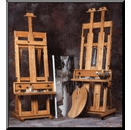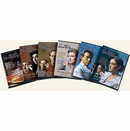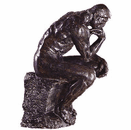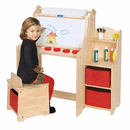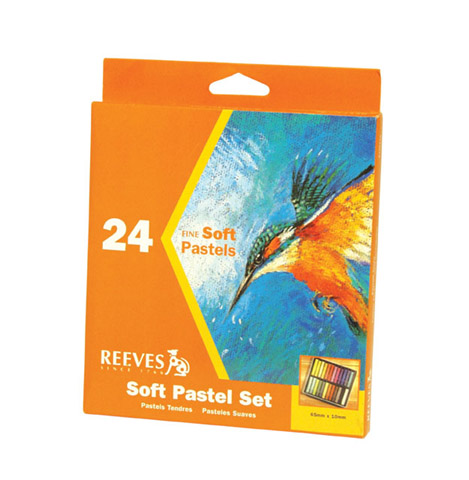REEVES Soft Pastel Set of 24
Product Description:
Reeves is one of the most trusted brands of color and their pastel set only goes to confirm on why this company has managed to be in service since 1766. They don’t compromise on quality and their pastel set is definitely a product that is value for the money spent. They should last you for quite some time unlike other brands, which can barely be used for more than a couple of times.
Product features:
- Set includes 24 soft pastels of varying colors.
- Each pastel is made of high quality pigments ensuring they produce very strong and vibrate colors.
- Very soft and tender on any surface, can’t scratch or tear your paper or canvas.
- Excellent strong appearance for blending colors.
- Perfect for use on cards or textured papers.
Customer Reviews
The History of Reeves
OUR HISTORY
Since 1766, Reeves has been synonymous with the manufacture of excellent quality fine art products. In a continuing quest for product improvement, Reeves combine the most recent technological advances with 200 years of manufacturing experience. A strong and traditional brand, with a celebrated history, it is no wonder that Reeves is now the fastest growing art brand in the world.
The Beginning
Reeves were an extremely family orientated business, brothers, son-in-laws, children and grandchildren all helped to give Reeves the quality reputation that it still holds today. However, it was the successful marketing of William Reeves (who founded Reeves in 1766) invention of the Moist Watercolour Paint-Cake, which placed Reeves at the forefront of manufacturing artists’ materials.
William opened his first shop near St Paul’s Cathedral in Well Lane, Little Britain, in 1766. Within two years the shop was doing so well that he took his older brother Thomas into partnership. As they were both bluecoat scholars they used the bluecoat boy as there initial trademark in 1770. However, Thomas Reeves later ‘discovered’ the greyhound crest which was subsequently adopted by William John Reeves the nephew of William. It had been taken from the arms of the extinct Ryves family of Dorset and consisted of a black-seated greyhound spotted with gold.
Nevertheless, William and Thomas were becoming so proud of their invention that they sent a sample to the society for the Encouragement of Arts, Manufactures and Commerce. The society of Arts (now known as the Royal Society of Arts) was suitably impressed by Reeves’ refinement of watercolour paints through the invention of the moist paint cake, and in 1781 awarded the Messrs Reeves the ‘Great’ silver palette ‘for the manufacture of Watercolour improved’
William thought of the moist paint cake concept while working at the Theatre Colourman. He noticed that gentry and artists paid a great deal for lumps of paint, which they could chip up, and use for watercolours. His training as a wire-drawer gave him the idea that paint may be extruded like wire and choppped into oblong cakes. However, he needed the paint to have a gelatinous consistency which no doubt after much experiment he eventually arrived at through the use of honey. Moreover it was an added discovery that honey kept the paint moist and ready to use.
Materials
William had the inventiveness and intransigence of a genius, it was this stubbornness combined with his strong principles and incompromising ways, that led him to his total estrangement from his family, he died an embittered man leaving his considerable fortune to his house keepers.
After his death
It was William’s brother Thomas – “a pillar of society” who put the family business on a secure foundation, he was well liked by customers and always open to new markets, selling ‘every article for drawing miniatures, landscapes, portraits, mappling, signals, fortification etc’ he had had in stock pens, pencils, brushes, paint bladders, a variety of palettes and porcelain mixing wells. The Reeves expansionist business traditions stems from Thomas Reeves
At first he had merely supplied William with a press to emboss paint cakes, but over the 15 years of partnership he built up an immense business.
However, William & Thomas split over a business disagreement. After the split with Thomas, William went into partnership with his son-in-law George Blackman, lasting seven years until increasing strife ended in a production quarrel. William refused to allow George to ‘improve’ his oil colours with a wax ingredient.
In the meantime William formed a relationship with John Inwood, who flourished as Wm Reeves until 1808, then as Reeves & Inwood after William’s death until about 1825.
The Workshop
William initially set up a shop in Well Lane, Little Britain; here he manufactured his own paints. The shop had a basement in which 3 young apprentices ground the pigment, and secretly used a new process - that of making paint–cakes. The paint was extruded in thick filaments, chopped into tablets, dried to the core and the tablets or cakes were wrapped in damp clothes to soften the outer crust ready for embossing. On the ground floor the shop itself was probably lined with shelves of filled boxes of paints on display and there were probably carboys of coloured liquids in the window. The counter would have displayed loose paint cakes, bladders of oil colour, paintbrushes and pencils.
Paint Cakes
William made a die and borrowed his brother’s press to make the first examples, giving his name and address at Little Britain. The cakes were later embossed with the bluecoat boy, in 1782 after the partnership with his brother; though none of these survive in London collections. Within the paint box, pasted on the lid the Artist Colourman would place a trade card, giving an exquisitely distinguished and authoritative appearance to the box.
The heraldic device on the paint cakes of Thomas & William John Reeves consisted of the Ryves shield combined with that of their partner William Woodyer, under the crest of an unspotted greyhound set into a large disk or coin.
The same shield without the dog was adopted by John Inwood, who after William’s death considered himself the true inheritor of the Reeves tradition. Inwood continued to use William Reeves’ name and impressed the words ‘original invention’ on his cakes. However, Inwood inadvertently copied the Woodyer arms. Thomas’ family were so angry they and their descendents warned customers in generations of catalogues ever since to beware of imitators.
Reeves and their East India Exports
Unlike Messrs Winsor & Newton the early Reeves family were not travellers. Reeves foreign markets grew effortlessly through contacts with the military academies, such as Woolwich and Addiscombe. Drawing instruments and colour boxes were needed by officers’ posted abroad on survey duties; and a large number of paint boxes, rolls of paper, stationery products were shipped by Reeves to India as military stores.
Apart from the exceptional purposes, such as keeping ‘General Buonoparte’ occupied while a prisoner on the Isle of St Helena, the great bulk of supplies was sent to India, and a trade card of ‘Reeves & Woodyer’ announced that they were ‘Colourmakers to the Honourable East India Company’. The Indians themselves called Reeves the ‘Dog’ company as there were no greyhounds in India.
However, in 1857 disaster struck with the Indian Mutiny and the decline of the East India Company. The richly profitable Indian market collapsed. The same year Reeves moved into smaller premises at 113 Cheapside. Fortunately the Managing Director at the time was WJ Reeves third son –Henry, a man of unusual flair and resourcefulness. Overseas the trade was extended to Peru, Brazil, Russia and the USA, while at home sales were increasing in all kinds of schools, which led to Henry taking a social interest in education. When the Education Act was passed in 1870, Reeves were well prepared. By 1866 Reeves was being run by Henry’s two nephews, Henry Wild and Charles Kemp Wild, who concentrated on cheaper paints – for schools and beginners, even publishing instruction books on art. Their success was so great that in 1868 they built a three-storey colour works at Dalston, four miles north of London.
Reeves into the 20th Century
The Greyhound Colour Works at Enfield became known especially for its famous Greyhound pastels. Its land had been brought in 1921. By 1927 two bays were added to take new plant for striking colour and mixing the newly developed Poster Colour (a ready made dextrine/gum Arabic medium), provided for the Commercial Art studios in the late twenties and thirties. In the forties, in addition to powder colours called Tempera, and the cheaper form of poster colours called Redimix Liquid Tempera Colour, Reeves also developed products for teachers who were not able to cope with powder colour mixing in large classes; these were Tempo discs and Temprablocks, ‘solid-block’ powder colours.
However, due to the bombing of the 2nd World War, Reeves premises at Cheapside were demolished, along with half the works at Dalston, many staff were also killed. Nevertheless, Greyhound products were still being made in Melbourne, Australia by Thomas Bell. Winsor & Newton too helped out with the school materials. Recovery after the air raids was swift. Reeves Labourites now produced light-fast colours and this brought them new markets in wallpapers, postage stamps, car spraying, and the manufacture of inks and so on. Reeves built a new factory at Enfield and moved from their main offices in Dalston in 1948.
After the War, the managing director Archibald G. Simmons saw the future of Reeves in the promotion of his overseas markets and embarked on an adventurous foreign policy. During the 1950s he visited Melbourne, Vancover, New York and Chicago and developed business projects in each of these cities. In the 1960s markets were opened in Latin America, India and South Africa.
By the time of the Bicentenary in 1966, Reeves had changed from the old establishment family business of the 1950s to a multi national combine.
Reeves merged in 1971 with Dryad Ltd Leicester a successful manufacturer and wholesaler of art and craft materials for schools and hospitals, to form Reeves Dryad Ltd. However, by 1974 Reeves had extended its empire and its capabilities so far as to need the backing of a much larger organisation to provide stability and resources commensurate with its responsibilities. Reckett and Colman gave Reeves the backing it required and under their aegis Reeves provided for the changing needs of artists and teachers of art better than ever before.
Reeves Today
In 1991, The Reeves business along with other fine art brands of Reckett and Colman, was acquired by the current owners AB Wilhelm Becker, who already owned Colart.
In 1999 Colart acquired Oasis Art & Craft Products Ltd, who had built up a leading position in the design, manufacture and supply of an extensive range of Children’s Art & Craft products, predominantely Painting by Numbers and Scraperfoil. Colart combined this business with their existing Reeves brand in one site located in Kidderminster where it operates from today.
Reeves continues to be a huge brand both in the UK and internationally, placed in over 70 countries worldwide including America, France, Germany, Italy, Japan, South Africa, Australia and Russia to name but a few and represents around 30% of our total business
OUR HISTORY
Since 1766, Reeves has been synonymous with the manufacture of excellent quality fine art products. In a continuing quest for product improvement, Reeves combine the most recent technological advances with 200 years of manufacturing experience. A strong and traditional brand, with a celebrated history, it is no wonder that Reeves is now the fastest growing art brand in the world.
The Beginning
Reeves were an extremely family orientated business, brothers, son-in-laws, children and grandchildren all helped to give Reeves the quality reputation that it still holds today. However, it was the successful marketing of William Reeves (who founded Reeves in 1766) invention of the Moist Watercolour Paint-Cake, which placed Reeves at the forefront of manufacturing artists’ materials.
William opened his first shop near St Paul’s Cathedral in Well Lane, Little Britain, in 1766. Within two years the shop was doing so well that he took his older brother Thomas into partnership. As they were both bluecoat scholars they used the bluecoat boy as there initial trademark in 1770. However, Thomas Reeves later ‘discovered’ the greyhound crest which was subsequently adopted by William John Reeves the nephew of William. It had been taken from the arms of the extinct Ryves family of Dorset and consisted of a black-seated greyhound spotted with gold.
Nevertheless, William and Thomas were becoming so proud of their invention that they sent a sample to the society for the Encouragement of Arts, Manufactures and Commerce. The society of Arts (now known as the Royal Society of Arts) was suitably impressed by Reeves’ refinement of watercolour paints through the invention of the moist paint cake, and in 1781 awarded the Messrs Reeves the ‘Great’ silver palette ‘for the manufacture of Watercolour improved’
William thought of the moist paint cake concept while working at the Theatre Colourman. He noticed that gentry and artists paid a great deal for lumps of paint, which they could chip up, and use for watercolours. His training as a wire-drawer gave him the idea that paint may be extruded like wire and choppped into oblong cakes. However, he needed the paint to have a gelatinous consistency which no doubt after much experiment he eventually arrived at through the use of honey. Moreover it was an added discovery that honey kept the paint moist and ready to use.
Materials
William had the inventiveness and intransigence of a genius, it was this stubbornness combined with his strong principles and incompromising ways, that led him to his total estrangement from his family, he died an embittered man leaving his considerable fortune to his house keepers.
After his death
It was William’s brother Thomas – “a pillar of society” who put the family business on a secure foundation, he was well liked by customers and always open to new markets, selling ‘every article for drawing miniatures, landscapes, portraits, mappling, signals, fortification etc’ he had had in stock pens, pencils, brushes, paint bladders, a variety of palettes and porcelain mixing wells. The Reeves expansionist business traditions stems from Thomas Reeves
At first he had merely supplied William with a press to emboss paint cakes, but over the 15 years of partnership he built up an immense business.
However, William & Thomas split over a business disagreement. After the split with Thomas, William went into partnership with his son-in-law George Blackman, lasting seven years until increasing strife ended in a production quarrel. William refused to allow George to ‘improve’ his oil colours with a wax ingredient.
In the meantime William formed a relationship with John Inwood, who flourished as Wm Reeves until 1808, then as Reeves & Inwood after William’s death until about 1825.
The Workshop
William initially set up a shop in Well Lane, Little Britain; here he manufactured his own paints. The shop had a basement in which 3 young apprentices ground the pigment, and secretly used a new process - that of making paint–cakes. The paint was extruded in thick filaments, chopped into tablets, dried to the core and the tablets or cakes were wrapped in damp clothes to soften the outer crust ready for embossing. On the ground floor the shop itself was probably lined with shelves of filled boxes of paints on display and there were probably carboys of coloured liquids in the window. The counter would have displayed loose paint cakes, bladders of oil colour, paintbrushes and pencils.
Paint Cakes
William made a die and borrowed his brother’s press to make the first examples, giving his name and address at Little Britain. The cakes were later embossed with the bluecoat boy, in 1782 after the partnership with his brother; though none of these survive in London collections. Within the paint box, pasted on the lid the Artist Colourman would place a trade card, giving an exquisitely distinguished and authoritative appearance to the box.
The heraldic device on the paint cakes of Thomas & William John Reeves consisted of the Ryves shield combined with that of their partner William Woodyer, under the crest of an unspotted greyhound set into a large disk or coin.
The same shield without the dog was adopted by John Inwood, who after William’s death considered himself the true inheritor of the Reeves tradition. Inwood continued to use William Reeves’ name and impressed the words ‘original invention’ on his cakes. However, Inwood inadvertently copied the Woodyer arms. Thomas’ family were so angry they and their descendents warned customers in generations of catalogues ever since to beware of imitators.
Reeves and their East India Exports
Unlike Messrs Winsor & Newton the early Reeves family were not travellers. Reeves foreign markets grew effortlessly through contacts with the military academies, such as Woolwich and Addiscombe. Drawing instruments and colour boxes were needed by officers’ posted abroad on survey duties; and a large number of paint boxes, rolls of paper, stationery products were shipped by Reeves to India as military stores.
Apart from the exceptional purposes, such as keeping ‘General Buonoparte’ occupied while a prisoner on the Isle of St Helena, the great bulk of supplies was sent to India, and a trade card of ‘Reeves & Woodyer’ announced that they were ‘Colourmakers to the Honourable East India Company’. The Indians themselves called Reeves the ‘Dog’ company as there were no greyhounds in India.
However, in 1857 disaster struck with the Indian Mutiny and the decline of the East India Company. The richly profitable Indian market collapsed. The same year Reeves moved into smaller premises at 113 Cheapside. Fortunately the Managing Director at the time was WJ Reeves third son –Henry, a man of unusual flair and resourcefulness. Overseas the trade was extended to Peru, Brazil, Russia and the USA, while at home sales were increasing in all kinds of schools, which led to Henry taking a social interest in education. When the Education Act was passed in 1870, Reeves were well prepared. By 1866 Reeves was being run by Henry’s two nephews, Henry Wild and Charles Kemp Wild, who concentrated on cheaper paints – for schools and beginners, even publishing instruction books on art. Their success was so great that in 1868 they built a three-storey colour works at Dalston, four miles north of London.
Reeves into the 20th Century
The Greyhound Colour Works at Enfield became known especially for its famous Greyhound pastels. Its land had been brought in 1921. By 1927 two bays were added to take new plant for striking colour and mixing the newly developed Poster Colour (a ready made dextrine/gum Arabic medium), provided for the Commercial Art studios in the late twenties and thirties. In the forties, in addition to powder colours called Tempera, and the cheaper form of poster colours called Redimix Liquid Tempera Colour, Reeves also developed products for teachers who were not able to cope with powder colour mixing in large classes; these were Tempo discs and Temprablocks, ‘solid-block’ powder colours.
However, due to the bombing of the 2nd World War, Reeves premises at Cheapside were demolished, along with half the works at Dalston, many staff were also killed. Nevertheless, Greyhound products were still being made in Melbourne, Australia by Thomas Bell. Winsor & Newton too helped out with the school materials. Recovery after the air raids was swift. Reeves Labourites now produced light-fast colours and this brought them new markets in wallpapers, postage stamps, car spraying, and the manufacture of inks and so on. Reeves built a new factory at Enfield and moved from their main offices in Dalston in 1948.
After the War, the managing director Archibald G. Simmons saw the future of Reeves in the promotion of his overseas markets and embarked on an adventurous foreign policy. During the 1950s he visited Melbourne, Vancover, New York and Chicago and developed business projects in each of these cities. In the 1960s markets were opened in Latin America, India and South Africa.
By the time of the Bicentenary in 1966, Reeves had changed from the old establishment family business of the 1950s to a multi national combine.
Reeves merged in 1971 with Dryad Ltd Leicester a successful manufacturer and wholesaler of art and craft materials for schools and hospitals, to form Reeves Dryad Ltd. However, by 1974 Reeves had extended its empire and its capabilities so far as to need the backing of a much larger organisation to provide stability and resources commensurate with its responsibilities. Reckett and Colman gave Reeves the backing it required and under their aegis Reeves provided for the changing needs of artists and teachers of art better than ever before.
Reeves Today
In 1991, The Reeves business along with other fine art brands of Reckett and Colman, was acquired by the current owners AB Wilhelm Becker, who already owned Colart.
In 1999 Colart acquired Oasis Art & Craft Products Ltd, who had built up a leading position in the design, manufacture and supply of an extensive range of Children’s Art & Craft products, predominantely Painting by Numbers and Scraperfoil. Colart combined this business with their existing Reeves brand in one site located in Kidderminster where it operates from today.
Reeves continues to be a huge brand both in the UK and internationally, placed in over 70 countries worldwide including America, France, Germany, Italy, Japan, South Africa, Australia and Russia to name but a few and represents around 30% of our total business
Copyright © 2002-2025 Madison Art Shop™ LLC. All Rights Reserved.


